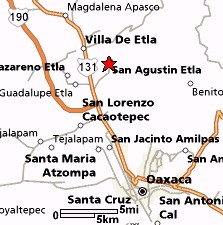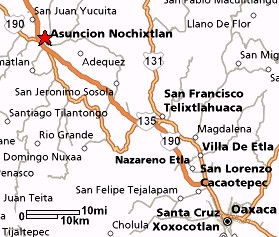
San Agustín Etla is located NW of Oaxaca
|
See photos for this article.
 San Agustín Etla is located NW of Oaxaca |
Half an hour from Oaxaca lies San Agustín Etla, a picturesque, mountainous area where a relatively new Cultural Arts Center has been established in a creatively remodeled textile factory, as well as a small workshop where I watched, fascinated, as five young men hand produced beautiful thick paper for artists made from raw cotton mixed with ixtle, the fiber from the maguey cactus. Both facilities evidence the influence and contributions of Francisco Toledo, Mexico's most famous living painter. Christian Viveros-Faune, an art historian, writes: "Toledo fuses dream images from his childhood with pre-Colombian symbolism and myriad references to the work of Dubuffet, Miro, Tapies, Klee, Tamayo, Blake, Goya, Ensor and Dürer, among other artists, and also to the writing of figures like Kafka and Borges. Snakes and turtles abound, as do rabbits and coyotes, bats and toads, crickets and dogs, as well as human figures from Mexican history, cycling from one work to another in a dizzying bestiary that is part ancient codex. Toledo's work is based in part on the shamanistic notion of the nagual, the belief that each human's fate is intertwined with that of an Aztec spirit in animal form."
Toledo, soft spoken and not very sociable, is more than a world-famous artist. He's donated millions of pesos--much of his wealth, to found libraries and museums in Oaxaca. He campaigned against a McDonald's in Oaxaca's zócalo, and cares passionately about preserving Oaxaca's architecture as well as its natural environment. I only vaguely remember something of a plan to build a chairlift up the side of the sacred Monte Albán mountain; it was Toledo who led the fight to defeat the proposal. My kinda guy.
As I was ready to leave the paper taller (tah YAIR), I turned, and there was Toledo who had just arrived. I was delighted! I'd been told he rarely visits. He was dressed as I've always seen him in photos--scruffily. I asked permission to take his picture as he created a piece he was donating to raise funds for the center. Quietly he gave a non-committal answer and went about his work. Deciding his comment was as least as much "yes" as "no", I stepped way back and watched him work for about half an hour, surreptitiously snapping a few shots. After quietly thanking Toledo and telling him how much I respect his work, I left grinning from ear to ear, feeling exceptionally lucky. A barely perceptible nod of his head was the only hint I got that he heard me.
My third venture that week was to several villages between 7,000 and 9,000 ft. high in the Sierra Madre Norte, also called the Sierra Juárez after Oaxaca's hero, Benito Juárez, who was born in Guelatao, my first stop. From Guelatao I went to Trinidad de Ixtlán then backtracked to several small towns including Natividad and Ixtlán. Among other discoveries, I found a working gold mine owned and operated by Canadians in tiny Natividad. I didn't even know that gold was actively mined in Oaxaca. Later I learned that there were to be hearings regarding the mine's environmental pollution toward the end of October, but they were mysteriously canceled.
I wasn't planning to go as far as Trinidad, but after riding for an hour and a bit, squished in the middle of the front seat of a colectivo taxi, a small Nissan Tsuru, I felt intimately acquainted with the passenger to my right as our bodies constantly pressed together when we rounded countless curves between Oaxaca and Ixtlán, the colectivo's last stop. I joked with him that we'd be engaged by the time we got to Ixtán, my original destination. Israel, 28, was on his way to check his corn fields, his milpa. He lives in Oaxaca, but his family has many hectares of land in Trinidad, most of it planted with maiz, now ready to harvest. When he invited me to continue with him by bus to Trinidad, I didn't hesitate. After we breakfasted at a little café we hiked down through a forest to his family home, to the church and the rest of the very little pueblo. Really fun.
The bus only passes by Trinidad twice a day. Thinking I'd missed the return bus, I bid farewell to Israel, and began the trek toward a place he told me I could catch a colectivo...about two miles from Trinidad. When at last I found the taxi, I overheard the driver conspiratorially radio someone that he'd found a "J-12" whom he might drive all the way to Oaxaca (I'd not said anything about that). I figured "J-12" was code for "a dumb, female foreign tourist I can con into a whopping fare", so I was thrilled that at that very moment, the tardy bus came chugging up the hill. I shot from the taxi and into the bus, pressing on to three other communities.
I went once more to Oaxaca toward the end of the month for another four days of exploring. I started by revisiting Teotitlán del Valle, a Zapotec town, the center of rug weaving in Oaxaca about an hour from the capital. I'd been there many years ago, but this time, I wanted to order a rug for The Little Cliff House. What was really fun, aside from reconnecting with the Bazán López family who've woven a number of my rugs, was choosing eight different wools, all dyed naturally, and planning the design of the carpet.

|
My next adventure took me to the Mixteca Alta, to the town of Nochixtlán, an important commercial center two and a half hours from Oaxaca of about 15,000 people, and from there to remote Santiago Apoala, another two hours up the mountain on a badly maintained dirt road in a packed camper-style pick-up (it's just too cold in those parts to travel in the open air), which I was lucky to catch. It goes once a day, but not every day and not on any schedule. Passing through forests of moss-draped encinos (holm oaks), I chatted with my fellow travelers and was lulled by their conversations in a mixture of Mixteco and Spanish. Trinidad (Yes, a pueblo and a person), my seatmate to the left, who lives a 45 minute walk from Nduaxceco, a wide spot in the road en route to Apoala, told me that in her community, almost all trade is done by barter, and that amazingly, no children are born with physical or mental handicaps. All births are performed by parteras, midwives, and there are no caesareans--ever. I questioned her quite closely, but she insisted that all babies are born healthy. What are they doing right there?
Surrounded by immensely high sheer cliffs (a bit reminiscent of Yosemite), tiny Apoala has a mystical, Balinese feel owing to the lush greenery and terrace farming. It's said to be the birthplace of the Mixtec people, where First Man and First Woman were born of the Tree of Life. Arriving late in the afternoon, I didn't have time to hike to the waterfalls, the stalactite-decorated caves or the oldest petroglyphs of the Mixtec people, but I did learn much about Apoala as I wandered about, including the legend of La Cueva del Diablo where, it's said, the Devil himself lived. For a very long time, a couple of centuries ago, newborns from Apoala disappeared in the middle of the night. That's why one young mother tied thread to her baby's foot before lying down to a restless sleep. Sure enough, the baby vanished, but the priest and the townspeople followed the thread to a cave high on the cliff face. There they found the remains of all the missing babies and the smell of the Devil. The priest carved three crosses at the entrance to Devil's Cave which caused the Evil One to flee Apoala; no babies have disappeared since. I feel I must return some day, and plan to stay in small cabañas the people have built. I'll set out at the crack of dawn from Oaxaca and even pay a private taxi from Nochixtlán if I have to. It'll cost $20 as opposed to $3.50, but so what? I really must go back.
Returning to Nochixtlán just after 7:00, I discovered I'd missed the bus to Oaxaca and would have to wait almost an hour. The 58 degree temperature felt colder because of a chilling wind, and I was freezing. I approached a young bus line inspector to ask if I could wait aboard a bus parked outside the open, unheated terminal. "You're from Puerto Escondido!" he greeted me. "Um, yes. How did you know?" "I'm from Puerto," he replied, and said that he used to be an inspector on the coast. He recognized the multi-colored windbreaker I always wear. We laughed together two hundred miles from home. Though I couldn't hide out in the empty bus, a bus from a different line pulled in just then. Quickly changing my ticket, I headed back to Oaxaca, shivering most of the way. Any discomfort, however, was worth it. What a great gift I gave myself this year!
See photos for this article.
![]() www.tomzap.com
www.tomzap.com
![]() Tom Penick:
tom@tomzap.com
Tom Penick:
tom@tomzap.com